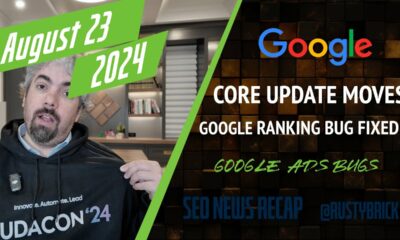SEO
Google Autocomplete: A Complete SEO Guide

Google Autocomplete is a controversial but powerful search feature.
When you type a word, or even a letter, into Google, it populates a list of search suggestions. That’s what autocomplete is.
SEO professionals, paid search marketers, content marketers, and social media managers can all benefit from using Google Autocomplete to help with different keyword-focused and intent-exploring projects.
On the other hand, Google Autocomplete often makes the news for funny, peculiar, or even offensive habits (often in a negative way).
People use autocomplete constantly, saving thousands of seconds per day, but it has also been blamed for political cover-ups and spoiling movies, TV shows, and video games.
Google Autocomplete can also be a powerful marketing tool. SEO professionals and other digital marketers have used it for years to inform strategy, get keywords, and find the important questions customers are asking.
They can use Autocomplete to better optimize clients’ digital properties and the content and messaging that make them up.
This guide will help you understand the real power this simple but super-helpful feature can do for help with your day-to-day tasks.
What Is Google Autocomplete?
Google’s own words, Google Autocomplete is “designed to make it faster to complete searches that you’re beginning to type.”
It’s integrated across Google Search and other Alphabet properties that use Google, including in the “Omnibox” on Chrome.
Google estimates that, cumulatively, it saves over 200 years of typing every day, and on average reduces typing overall by about 25 percent.
The primary purpose of the Autocomplete dropdown is to cut back on time a user spends typing by offering predictions of what a user may be typing — including for websites using the built-in Google Custom Search Engine feature.
While Autocomplete has been a desktop search feature since late 2004, it has become even more useful as a time-saving feature on mobile devices.
Typing on a mobile device is a bit tougher than doing so on the large keyboards we have grown up with and are accustomed to, so it’s a welcomed tool for providing assistance and saving time for many.
There are several other useful ways that the feature can be used to leverage content ideas, keyword suggestions, intent exploration, online reputation management, and other data-driven tasks.
How Does Autocomplete Work?
Ex-Googler Kevin Gibbs created the project, originally called “Google Suggest” by another former Googler Marissa Mayer.
Google has since moved away from the “Suggest” name since it’s not always offering the most thoughtful, caring, or appropriate predictions.
Google calls the completions it offers “predictions”, not “suggestions.” This is because of how Autocomplete works.
Autocomplete is supposed to help people complete a sentence they were intending – not to suggest a search intent, as with “I’m feeling lucky.” They determine predictions by looking at common searches on Google, including looking at trending searches that might be relevant.
This allows Autocomplete to quickly update and adapt to new search trends and news stories.
Much of Autocomplete’s behavior is computer-generated, with data collected from millions of other Google searches and their results, including the content on those pages. It also takes information from your search history, location, and other data points.
Google has also put a lot of work in, so as to avoid inappropriate or offensive autocomplete suggestions. This means there are both automated and manual removal procedures that can influence what autocomplete suggestions are left.
Autocomplete is also related to the Knowledge Graph, and especially on mobile, it can bring Knowledge Graph suggestions into the prediction.
It wasn’t until 2008 that Google built Autocomplete into its default search engine (it was previously an opt-in feature).
Best Ways to Use Google Autocomplete
1. Keyword Research
It’s a long, tedious, and laborious task, but it’s also the foundation of all SEO strategies– and has been for a long time.
While we may no longer explicitly target keywords, keywords and their related ideas are always going to be an important part of search marketing.
Keyword research is one of the first tasks tackled at the start of an engagement — and carried on throughout the engagement — to understand not just a brand and the content it creates, but also its potential shortcomings, website strengths and weaknesses, and content gaps.
Autocomplete doesn’t do all the work for you in terms of keyword research, but it’s a great place to start at or to use early and often when developing content calendars and general organic search strategies.
Using it (along with other keyword resource tools like Google Keyword Planner and other third-party keyword databases) to get an idea of the right keywords you want to target by considering monthly search frequency, competition, and even cost-per-click (CPC) pricing will do your search strategy justice.
One of the shining advantages of Google Autocomplete is its ability to uncover quality long-tail phrases that are commonly searched across the web.
Since the primary measure for Autocomplete is popularity — based on real searches by users in real-time — the value of Autocomplete lies in its plethora of keyword-level data that you can dig up if you work at it hard and long enough.
As always, be sure you are signed out of Google to ensure you limit personalization for an unbiased look at predictions.
Long-tail keywords are incredibly useful when fulfilling content gaps but also offer endless possibilities in terms of high-value blog posts and educational content within a brand’s niche.
2. Intent Exploration
Understanding user intent is important because it guides the goal of the page, its messaging, its layout, and even imagery. We know pages perform best when they fully satisfy the user intent of a search query.
You can use Autocomplete to better understand user intent, but doing so can be involved and laborious. Taking the time to visit many different web pages in the search results tied to specific predictions is going to take some time, focus, and content consumption. But the information you can mine from this method is invaluable.
Keywords overlap various stages of user intent, and without more keyword context, it can be tough to understand the intent.
Autocomplete will help you not just understand different high-value long-tail keywords and the intent surrounding them, but it will also help marketers recognize the volume of content around specific stages of intent, as well as which long-tail phrases and intent stages could be optimized for as a higher priority.
Of course, for high-value keywords — long-tail or traditional one-, two-, and three-word phrases — it’s important to satisfy all stages of intent as they relate to the high-value keywords.
That’s the idea behind an all-encompassing, quality search strategy. And Autocomplete can help get you there.
3. Online Reputation Management
Autocomplete has been significant in the realm of online reputation management, too.
Remember, when a user searches for your name or your brand name, the first thing they see, even before your site on the SERP (search engine results page), is the Autocomplete predictions tied to that name.
If those predictions are negative, or if even just one of them is negative, it can have a real impact on your business’s performance.
Think about it. You search [Dog Washers Inc] and the first prediction finishes with “loses dog,” you probably won’t feel too keen on bringing your dog there for his next bath.
Same for a restaurant; if you search [Ted’s Seaford Spot] and the prediction finishes with “e. Coli,” I have a pretty good idea of what you’re not eating tonight.
Autocomplete makes up an important part of online reputation management (ORM) and cannot be ignored when working to balance all negative connections made with brands.
One must be vigilant, just like most ORM strategies. Several ways brands can work to offset negative Autocomplete predictions are:
- Take control of your brand’s conversations to ensure the right connections are being made in Google Autocomplete.
- Social media account optimization reinforces the positive connections that may be overshadowed by negative ones.
- Social media content, messaging, and engagement are in line with the optimizations above and the brand’s voice and tone.
- Consistent branding and messaging for profile websites with positive keywords association used elsewhere
- Starting small and making an impact by searching for positive connections for the brand from different locations. Obviously, the more people, the better. But you’d be surprised at the impact it can have.
- Building backlinks to Google SERPs for positive keyword associations with your name; things like [sam hollingsworth seo writer] and [sam hollingsworth handicapper] would be great starts for someone like myself. 😊
- If there are negative autocomplete suggestions, ensure that you have a strategy of how to address them.
4. Content Generation and Exploration
You can also now use Autocomplete for content generation and exploring competitor content for your own content ideas. It’s easy, and interesting, to use Autocomplete alongside other online writing tools, to find out what web users are searching for.
FAQs
Just looking at “who”, “what”, “where”, “when”, and “why” with a few brand-related questions can get you a ton of questions for your FAQ– questions people may already be searching for.
Related keywords
You can do this in many ways, for many reasons. An easy one is “brand name vs.”– Google will autofill with competitors. You can also look at “brand name and” and see what autocomplete finds there– finding ways to expand your brand.
Related topics
If you can find Autocomplete suggestions for related topics, that aren’t covered by your main topic, you might have an edge to grow some content in that niche.
Queries like “how * works” can be invaluable, autocomplete filling in the wildcard space with suggestions. You can also do this to find questions about your brand, questions for content marketing, find problems potential customers are looking for, and even find out if users are looking for certain social media accounts.
Autocomplete Policies
With a history of backlash due to some of its search predictions, Google does manually work to prevent inappropriate Autocomplete predictions when it comes to:
- Sexually explicit predictions.
- Hateful predictions against groups and individuals.
- Violent predictions.
- Danger and harmful activities in predictions.
It also may remove predictions that could be considered spam, facilitate or advocate piracy, or if given a legal request to do so.
Google makes it clear that it removes predictions that relate to any of the above-mentioned situations unless they contain medical or scientific terms that are not malicious.
Looking for Feedback
To better control inappropriate Autocomplete predictions, Google launched its feedback tool and uses the data to make improvements consistently.
For instance, there doesn’t have to be a particular demographic that is being targeted by something hateful in nature; and feedback helps get that discovered faster and easier.
 Screenshot of Google Search, November 2021
Screenshot of Google Search, November 2021Understanding what people are actually searching for is an essential part of your SEO strategy.
See how you can incorporate Google Autocomplete into your research process. You just might be surprised at the specific keywords and search intent it reveals!
More SEO Resources:
Featured image: Shutterstock/Fonstra
SEO
WordPress Insiders Discuss WordPress Stagnation

A recent webinar featuring WordPress executives from Automattic and Elementor, along with developers and Joost de Valk, discussed the stagnation in WordPress growth, exploring the causes and potential solutions.
Stagnation Was The Webinar Topic
The webinar, “Is WordPress’ Market share Declining? And What Should Product Businesses Do About it?” was a frank discussion about what can be done to increase the market share of new users that are choosing a web publishing platform.
Yet something that came up is that there are some areas that WordPress is doing exceptionally well so it’s not all doom and gloom. As will be seen later on, the fact that the WordPress core isn’t progressing in terms of specific technological adoption isn’t necessarily a sign that WordPress is falling behind, it’s actually a feature.
Yet there is a stagnation as mentioned at the 17:07 minute mark:
“…Basically you’re saying it’s not necessarily declining, but it’s not increasing and the energy is lagging. “
The response to the above statement acknowledged that while there are areas of growth like in the education and government sectors, the rest was “up for grabs.”
Joost de Valk spoke directly and unambiguously acknowledged the stagnation at the 18:09 minute mark:
“I agree with Noel. I think it’s stagnant.”
That said, Joost also saw opportunities with ecommerce, with the performance of WooCommerce. WooCommerce, by the way, outperformed WordPress as a whole with a 6.80% year over year growth rate, so there’s a good reason that Joost was optimistic of the ecommerce sector.
A general sense that WordPress was entering a stall however was not in dispute, as shown in remarks at the 31:45 minute mark:
“… the WordPress product market share is not decreasing, but it is stagnating…”
Facing Reality Is Productive
Humans have two ways to deal with a problem:
- Acknowledge the problem and seek solutions
- Pretend it’s not there and proceed as if everything is okay
WordPress is a publishing platform that’s loved around the world and has literally created countless jobs, careers, powered online commerce as well as helped establish new industries in developing applications that extend WordPress.
Many people have a stake in WordPress’ continued survival so any talk about WordPress entering a stall and descent phase like an airplane that reached the maximum altitude is frightening and some people would prefer to shout it down to make it go away.
Acknowledging facts and not brushing them aside is what this webinar achieved as a step toward identifying solutions. Everyone in the discussion has a stake in the continued growth of WordPress and their goal was to put it out there for the community to also get involved.
The live webinar featured:
- Miriam Schwab, Elementor’s Head of WP Relations
- Rich Tabor, Automattic Product Manager
- Joost de Valk, founder of Yoast SEO
- Co-hosts Matt Cromwell and Amber Hinds, both members of the WordPress developer community moderated the discussion.
WordPress Market Share Stagnation
The webinar acknowledged that WordPress market share, the percentage of websites online that use WordPress, was stagnating. Stagnation is a state at which something is neither moving forward nor backwards, it is simply stuck at an in between point. And that’s what was openly acknowledged and the main point of the discussion was understanding the reasons why and what could be done about it.
Statistics gathered by the HTTPArchive and published on Joost de Valk’s blog show that WordPress experienced a year over year growth of 1.85%, having spent the year growing and contracting its market share. For example, over the latest month over month period the market share dropped by -0.28%.
Crowing about the WordPress 1.85% growth rate as evidence that everything is fine is to ignore that a large percentage of new businesses and websites coming online are increasingly going to other platforms, with year over year growth rates of other platforms outpacing the rate of growth of WordPress.
Out of the top 10 Content Management Systems, only six experienced year over year (YoY) growth.
CMS YoY Growth
- Webflow: 25.00%
- Shopify: 15.61%
- Wix: 10.71%
- Squarespace: 9.04%
- Duda: 8.89%
- WordPress: 1.85%
Why Stagnation Is A Problem
An important point made in the webinar is that stagnation can have a negative trickle-down effect on the business ecosystem by reducing growth opportunities and customer acquisition. If fewer of the new businesses coming online are opting in for WordPress are clients that will never come looking for a theme, plugin, development or SEO service.
It was noted at the 4:18 minute mark by Joost de Valk:
“…when you’re investing and when you’re building a product in the WordPress space, the market share or whether WordPress is growing or not has a deep impact on how easy it is to well to get people to, to buy the software that you want to sell them.”
Perception Of Innovation
One of the potential reasons for the struggle to achieve significant growth is the perception of a lack of innovation, pointed out at the 16:51 minute mark that there’s still no integration with popular technologies like Next JS, an open-source web development platform that is optimized for fast rollout of scalable and search-friendly websites.
It was observed at the 16:51 minute mark:
“…and still today we have no integration with next JS or anything like that…”
Someone else agreed but also expressed at the 41:52 minute mark, that the lack of innovation in the WordPress core can also be seen as a deliberate effort to make WordPress extensible so that if users find a gap a developer can step in and make a plugin to make WordPress be whatever users and developers want it to be.
“It’s not trying to be everything for everyone because it’s extensible. So if WordPress has a… let’s say a weakness for a particular segment or could be doing better in some way. Then you can come along and develop a plug in for it and that is one of the beautiful things about WordPress.”
Is Improved Marketing A Solution
One of the things that was identified as an area of improvement is marketing. They didn’t say it would solve all problems. It was simply noted that competitors are actively advertising and promoting but WordPress is by comparison not really proactively there. I think to extend that idea, which wasn’t expressed in the webinar, is to consider that if WordPress isn’t out there putting out a positive marketing message then the only thing consumers might be exposed to is the daily news of another vulnerability.
Someone commented in the 16:21 minute mark:
“I’m missing the excitement of WordPress and I’m not feeling that in the market. …I think a lot of that is around the product marketing and how we repackage WordPress for certain verticals because this one-size-fits-all means that in every single vertical we’re being displaced by campaigns that have paid or, you know, have received a a certain amount of funding and can go after us, right?”
This idea of marketing being a shortcoming of WordPress was raised earlier in the webinar at the 18:27 minute mark where it was acknowledged that growth was in some respects driven by the WordPress ecosystem with associated products like Elementor driving the growth in adoption of WordPress by new businesses.
They said:
“…the only logical conclusion is that the fact that marketing of WordPress itself is has actually always been a pain point, is now starting to actually hurt us.”
Future Of WordPress
This webinar is important because it features the voices of people who are actively involved at every level of WordPress, from development, marketing, accessibility, WordPress security, to plugin development. These are insiders with a deep interest in the continued evolution of WordPress as a viable platform for getting online.
The fact that they’re talking about the stagnation of WordPress should be of concern to everybody and that they are talking about solutions shows that the WordPress community is not in denial but is directly confronting situations, which is how a thriving ecosystem should be responding.
Watch the webinar:
Is WordPress’ Market share Declining? And What Should Product Businesses Do About it?
Featured Image by Shutterstock/Krakenimages.com
SEO
Google’s New Support For AVIF Images May Boost SEO

Google announced that images in the AVIF file format will now be eligible to be shown in Google Search and Google Images, including all platforms that surface Google Search data. AVIF will dramatically lower image sizes and improve Core Web Vitals scores, particularly Largest Contentful Paint.
How AVIF Can Improve SEO
Getting pages crawled and indexed are the first step of effective SEO. Anything that lowers file size and speeds up web page rendering will help search crawlers get to the content faster and improve the amount of pages crawled.
Google’s crawl budget documentation recommends increasing the speeds of page loading and rendering as a way to avoid receiving “Hostload exceeded” warnings.
It also says that faster loading times enables Googlebot to crawl more pages:
Improve your site’s crawl efficiency
Increase your page loading speed
Google’s crawling is limited by bandwidth, time, and availability of Googlebot instances. If your server responds to requests quicker, we might be able to crawl more pages on your site.
What Is AVIF?
AVIF (AVI Image File Format) is a next generation open source image file format that combines the best of JPEG, PNG, and GIF image file formats but in a more compressed format for smaller image files (by 50% for JPEG format).
AVIF supports transparency like PNG and photographic images like JPEG does but does but with a higher level of dynamic range, deeper blacks, and better compression (meaning smaller file sizes). AVIF even supports animation like GIF does.
AVIF Versus WebP
AVIF is generally a better file format than WebP in terms of smaller files size (compression) and image quality. WebP is better for lossless images, where maintaining high quality regardless of file size is more important. But for everyday web usage, AVIF is the better choice.
See also: 12 Important Image SEO Tips You Need To Know
Is AVIF Supported?
AVIF is currently supported by Chrome, Edge, Firefox, Opera, and Safari browsers. Not all content management systems support AVIF. However, both WordPress and Joomla support AVIF. In terms of CDN, Cloudflare also already supports AVIF.
I couldn’t at this time ascertain whether Bing supports AVIF files and will update this article once I find out.
Current website usage of AVIF stands at 0.2% but now that it’s available to surfaced in Google Search, expect that percentage to grow. AVIF images will probably become a standard image format because of its high compression will help sites perform far better than they currently do with JPEG and PNG formats.
Research conducted in July 2024 by Joost de Valk (founder of Yoast, ) discovered that social media platforms don’t all support AVIF files. He found that LinkedIn, Mastodon, Slack, and Twitter/X do not currently support AVIF but that Facebook, Pinterest, Threads and WhatsApp do support it.
AVIF Images Are Automatically Indexable By Google
According to Google’s announcement there is nothing special that needs to be done to make AVIF image files indexable.
“Over the recent years, AVIF has become one of the most commonly used image formats on the web. We’re happy to announce that AVIF is now a supported file type in Google Search, for Google Images as well as any place that uses images in Google Search. You don’t need to do anything special to have your AVIF files indexed by Google.”
Read Google’s announcement:
Supporting AVIF in Google Search
Featured Image by Shutterstock/Cast Of Thousands
SEO
CMOs Called Out For Reliance On AI Content For SEO

Eli Schwartz, Author of Product-Led SEO, started a discussion on LinkedIn about there being too many CMOs (Chief Marketing Officers) who believe that AI written content is an SEO strategy. He predicted that there will be reckoning on the way after their strategies end in failure.
This is what Eli had to say:
“Too many CMOs think that AI-written content is an SEO strategy that will replace actual SEO.
This mistake is going to lead to an explosion in demand for SEO strategists to help them fix their traffic when they find out they might have been wrong.”
Everyone in the discussion, which received 54 comments, strongly agreed with Eli, except for one guy.
What Is Google’s Policy On AI Generated Content?
Google’s policy hasn’t changed although they did update their guidance and spam policies on March 5, 2024 at the same time as the rollout of the March 2024 Core Algorithm Update. Many publishers who used AI to create content subsequently reported losing rankings.
Yet it’s not said that using AI is enough to merit poor rankings, it’s content that is created for ranking purposes.
Google wrote these guidelines specifically for autogenerated content, including AI generated content (Wayback machine copy dated March 6, 2024)
“Our long-standing spam policy has been that use of automation, including generative AI, is spam if the primary purpose is manipulating ranking in Search results. The updated policy is in the same spirit of our previous policy and based on the same principle. It’s been expanded to account for more sophisticated scaled content creation methods where it isn’t always clear whether low quality content was created purely through automation.
Our new policy is meant to help people focus more clearly on the idea that producing content at scale is abusive if done for the purpose of manipulating search rankings and that this applies whether automation or humans are involved.”
Many in Eli’s discussion were in agreement that reliance on AI by some organizations may come to haunt them, except for that one guy in the discussion
Read the discussion on LinkedIn:
Too many CMOs think that AI-written content is an SEO strategy that will replace actual SEO
Featured Image by Shutterstock/Cast Of Thousands
-

 SEO7 days ago
SEO7 days agoGoogle’s Revamped Documentation Shows 4 Reasons To Refresh Content
-
SEARCHENGINES5 days ago
Daily Search Forum Recap: August 26, 2024
-

 SEARCHENGINES7 days ago
SEARCHENGINES7 days agoGoogle Ranking Bug Fixed, August Core Update Swings, AI Overviews, Google Ads Bug & More
-

 WORDPRESS7 days ago
WORDPRESS7 days agoHow to Secure Your WordPress Store
-
SEARCHENGINES4 days ago
Daily Search Forum Recap: August 27, 2024
-

 AFFILIATE MARKETING7 days ago
AFFILIATE MARKETING7 days agoBusiness Owners are Batting 1,000 With This All-in-One Management Hub
-

 SEARCHENGINES6 days ago
SEARCHENGINES6 days agoGoogle Migrating All To Google Merchant Center Next By September
-

 WORDPRESS5 days ago
WORDPRESS5 days ago10 Best StudioPress Alternatives (Genesis Framework)















You must be logged in to post a comment Login